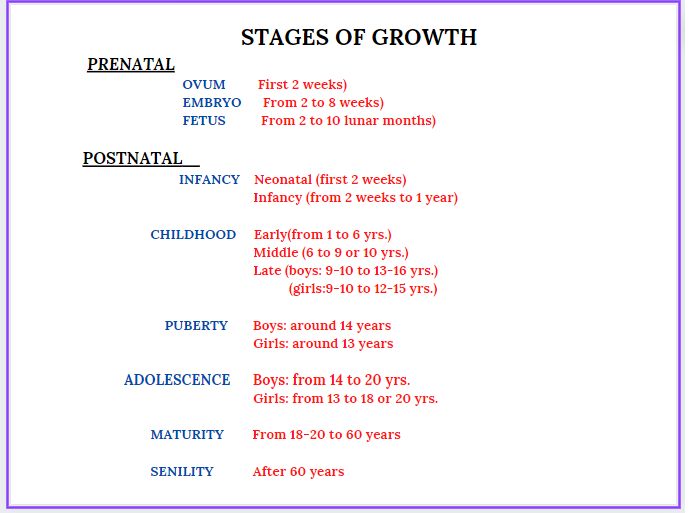Difference between growth and development
Growth and development are sometimes used together. But they are not exactly the same. Growth and development are characterized and defined by the way in which humans change in size, shape, and maturity relative to the passage of time.
Growth:
- Growth means the physical change and increases in the size of the various parts and organs of the body by the multiplication of cells and intercellular components during the period commencing from fertilization to physical maturity. It can be measured. Indicators of growth include height, weight, bone size, and dentition.
Development:
- Development refers to the increase of functional capacity and skill progression. It is the capacity and skill of a person to function.
Methods of growth study
• Longitudinal study: – Each child is measured at certain intervals of time over any number of years. The investigation may cover a couple of years or certain stages of growth, or it may be from birth to maturity.
• Cross-sectional study: – Each child is measured once only. The children of one age group are pooled together and the average values are obtained.
• Mixed-longitudinal: – The children of a particular age are measured at different periods. But when for certain reasons some of the children are not available during the next time of measurement, they are replaced by another set of children to keep the continuity. This type of study is more complicated.
Stages of Growth
• A simple classification of the postnatal period includes four stages early childhood, later childhood, adolescence, and puberty; or early childhood, middle childhood, late childhood, and adolescence.
A detailed classification, proposed by R.L.Scammon (1930), is given below:


There are three ways to measure growth:-
Linear measurements, such as height, head length, nose length, sitting height, etc., are assessed in terms of lengthening.
Areal measurements, like the circumference of the head, refer to the expansion of surface areas.
Ponderal measurements, on the other hand, refer to the growth of mass or weight.
Factors Affecting Growth:
• Genetic factors: Hereditary influence, chromosomal abnormalities, hormonal influence.
• Environmental Factors: Nutrition, State of health, Psychological Disturbance, Socio-cultural condition, Ecology.
Genetic factors:
• Parents contribute to their children some genetic components in shaping the pattern of growth is obvious from the fact that there are resemblances between the parents and children in respect of height, weight, body proportions, rate of growth, etc.
• Twin studies provide ample information on the influence of hereditary on growth.
• Chromosomal abnormalities suggest genetic control on growth. Male individuals with Klinefelter’s syndrome (XXY) are on average taller than normal males. On the other hand, phenotypically females with one X chromosome are shorter on average than normal females.
• Hormonal influence is another important factor in growth. Growth is regulated by the actions and interactions of hormones. The changes during adolescence are caused by hormones. An imbalance or disorder in the secretion of hormones may lead to abnormal growth.
• Three hormones play a vital role in regulating the orderly process of growth. These are thyroid, pituitary, and adrenal hormones.
Environmental Factor:
- The term environment encompasses a large number of variables, some of which are interlinked with one another, diet, mineral contents of the soil, humidity, altitude, temperature, sociocultural behavior, socio-economic condition, etc., are included in the environment.
- Nutrition: Adequate supplies of vitamins, minerals, water, etc., are necessary for the multiplication of cells and their enlargement in size. Nutritional deficiencies impair normal growth during childhood and delay the appearance of an adolescent spurt.
- State of health: Illness, minor or major may affect normal growth. Malnourished people very often lack the power of resistance to different kinds of diseases. Chronic anemia may retard growth.
- Psychological Disturbance: The secretion of growth hormones is affected by the emotional and psychological environment of a person.
- Socio-cultural condition: Socio-cultural condition includes all aspects of the way of life such as socio-economic class, size of family and cultural behavior, etc.
- Ecology: The children living at high altitudes on average are shorter and lighter than their counterparts on the plains. Chest dimensions in relation to stature, are greater living in the high altitude than the lowland dwellers.
- Climate: It is another factor associated with differences in body size, body proportions, and body composition. It has been found that people in colder climates show a tendency to be heavier with relatively large trunks and shorter legs. On the other hand, in hotter climates, they tend to have lighter and longer-legged bodies.
Difference between Human Growth and Development:
- The term ‘growth’ and ‘development’ are generally used synonymously but in the biological sense, they are not the same.
- Growth refers to the increase in size and weight of the body. Development refers to the changes that take place in the structure of the body during growth.
- Growth and development are considered together because the child grows as well as develops simultaneously.
- Growth is an increase in the size of the body or any of its parts and the Development Functional changes that occur during growth.
- in growth Increase in height and weight with reference to age and development Increase of other factors such as mental, social, and secondary sexual characteristics.
- growth can be measured quantitatively but development can be measured qualitatively.
- growth is stopped after a certain age but development is a continuous process.
- Growth is uni-directional while development is bi-directional.
SOME OTHER FACT
Adolescence Growth Spurt: A period of rapid increase in height, weight, and muscle mass, which for boys takes place at age 12 to 16 years and for girls at ages 11 to 14 years.
Secular Trend: A marked tendency to become progressively larger in size, i.e., becoming taller and heavier, at all ages. This sort of trend is known as a secular trend.
Canalization: The power to stabilize and return to a predetermined growth curve after being pushed through illness or starvation. This property is called by Waddington ‘Canalization’ or ‘Homeorhesis’.
Peak Height Velocity: PHV is a measure of the maximum rate of growth in stature during a growth spurt. The age of maximum velocity of growth is called the age at PHV.
Prediction of adult Height:
The adult height of a person depends upon a complex interaction between his genotype and the environment. The genotype fixes the ultimate limit to be achieved and favorable environmental factors help to accomplish that target.
TYPES OF GROWTH IN HUMAN
Physical Growth: The term “physical growth” describes an individual’s weight, height, and other physical developments.
MentalDevelopment: Mental Development helps a child’s mind grow so they can solve problems, form opinions, etc.
Emotional Development: This is the expansion of an individual’s feelings, such as love, joy, rage, hate, etc.
Social Growth: The development of a person as a result of interactions with various social groupings is referred to as social growth.
These thus are the four major categories of growth.





